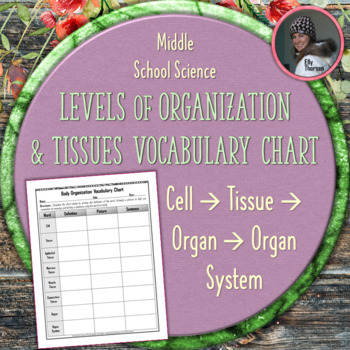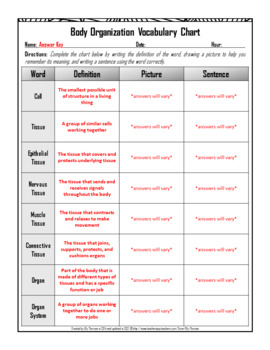Levels of Organization Vocabulary Chart: Cells, Tissues, Organs, and Systems
Elly Thorsen
4.3k Followers
Elly Thorsen
4.3k Followers
What educators are saying
This resource made it easy for my students to understand how everything is related in body systems and the vocabulary saved me a lot of time.
Also included in
- This bundle is all about the levels of organization in the human body. All resources in the bundle reinforce that the body's organization goes in the order of cell, tissue, organ, organ system, and body. What's in this bundle?Levels of Organization Analogies Worksheet: It's a one page worksheet thatPrice $7.00Original Price $9.40Save $2.40
Description
This resource helps students remember the definitions for the following body organization vocabulary words: cell, tissue, epithelial tissue, nervous tissue, muscle tissue, connective tissue, organ, and organ system. Students will complete the chart by writing the definition, drawing a picture, and using the word in a sentence. This is useful near the beginning of a unit on body organization or as a quick review.
This resource is a part of the Levels of Organization in the Human Body Bundle.
Take a look at the many other Human Body Resources in my store.
***Look for the green star near the top of any page in my store and click it to become a follower. As a follower of my store you will be notified when I upload a new resource.
Total Pages
3 pages
Answer Key
Included
Teaching Duration
N/A
Report this resource to TPT
Reported resources will be reviewed by our team. Report this resource to let us know if this resource violates TPT’s content guidelines.
Standards
to see state-specific standards (only available in the US).
NGSSMS-LS1-3
Use argument supported by evidence for how the body is a system of interacting subsystems composed of groups of cells. Emphasis is on the conceptual understanding that cells form tissues and tissues form organs specialized for particular body functions. Examples could include the interaction of subsystems within a system and the normal functioning of those systems. Assessment does not include the mechanism of one body system independent of others. Assessment is limited to the circulatory, excretory, digestive, respiratory, muscular, and nervous systems.






